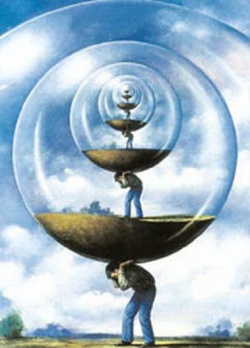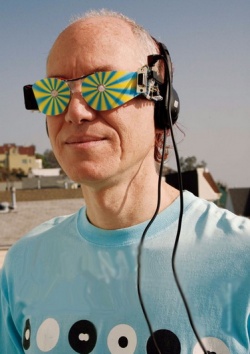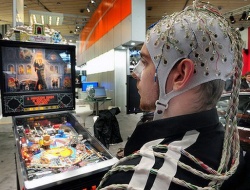What is Consciousness? : Vijnana
'What is consciousness (vijnana)? It consists of the
six groups of consciousness (sad vijnanakayah), viz.
visual consciousness(caksurvijnana), auditory (srotra),
olfactory (ghrana), gustatory (jihva), tactile (kaya),
and mental consciousness (manovijnana) -- Asanga,
as quoted by Ven. Dr. Walpola Rahula in his essay
Alayavijnana - Store Consciousness
In the Suttas of the Nikayas, the Buddha talks about 6 organs of sensation, 6 vinnana {consciousness of sensation}, and 6 objects of sensation; so we have the 18 sensory realms. My understanding is that the 6 organs are the doors of perception; the eyes, ears, nose, mouth, body, and brain. The vinnana are the sensations; sight, hearing, smell, taste, touch, & perception. The objects are quantifiable attributes; form, sound, aroma, flavor, texture, and phenomena.
So, it appears that if there is no sensory contact; then there can be no vijnana. If we consider the kama-dhatu, or the realm of desire; where most of us dwell most of the time, there is both contact and lusty desire {kamachanda}. Therefore, in the realm of desire, there is vijnana consciusness,
Next, consider the rupa-dhatu, a meditative realm attained via a stage of Samatha Meditation called rupa-dhyana or jhana, meaning form meditation or form absorption. In this realm of form, there is no kamachanda / lust, but there is still contact with the 6 objects of sensation. So, in the realm of form, it appears that there is still vijnana consciousness.
Finally, let us consider the arupa-dhatu or formless realm. This is also a meditative state, amd is attained via a stage of samatha meditation. In this case the stage is attainment, or samapatti; sometimes called arupa- dhyana, or formless meditation. In this realm, there is neither lust nor contact with the objects of sensation, so there can be no vijnana? Yet there appears to be cognizance of noumena.
So from this, I think we can infer that there is some sort of consciousness other than vijnana? Indeed, in the suttas, the Buddha uses several different terms that appear to mean consciousness. These include vijnana; which is inclusive of some level of mental or brain consciousness, the mano-vijnana; manas; and citta. Note that manas and mano are the same word. Mono is simply a form used in compound words, as with psyche and psycho.
So many have concluded that mano-vijnana and manas are simply the same thing. Moreover, citta is also taken as a synonym for vijnana and manas. According to Ven. Dr. Walpola Rahula; the Theravada Tipitaka, Pali Commentaries, the Sarvistivada, the Lankavatara Sutra, and Vasubandhu's Vimsatikavijnapti-matratasiddhi all take them as denoting the same thing. However, according Dr, Rahula, the Fourth Century CE Buddhist Sage Asanga had a different take, "He divides the vijnanaskandha (Aggregate of Conciousness) the fifth of the five skandhas, into three different aspects or layers, namely, citta, manas and vijnana." -- ibid
From Asanga's work, we can, perhaps, infer that mano-vinnana is indeed dependent on contact, that is limited to the preceptive consciousnesses that is generated by contact of the 6 doors of perceptions with the 6 objects of sensation. However, as the example of the formless realm; there must be consciousness independent of sensation.
This is not the only contradiction inherent in the traditional or conventional interpretations of the Suttas. The Buddha also talked about luminous citta. According to him, citta is originally pure, but becomes adulterated through contact with "adventitious minor defilements' (agantukehi upakkilesehi upakkilittham." (ibid). He also explained that mindfulness meditation purifies citta, so that it is once again luminous, freed of defilements.
"Luminous, monks, is the mind. And it is
freed from incoming defilements. The well
instructed disciple of the noble ones
discerns that as it actually is present,
which is why I tell you that — for the
well-instructed disciple of the noble
ones — there is development of the mind."
{I,vi,2} -- AN 1.49-52Pabhassara Sutta
There is also the matter of The Udana {the third book of the Khuddaka Nikaya}, "... since there is an unborn [deathless, constant], an un-become [steadfast, firmly established], an unmade [true, original, authentic, not fabricated], an unconditioned [pure, unsullied], therefore is there release from what is born anicca, become dukkha, made anatta, and conditioned [impure]."
I suspect that it was these problems which Asanga and the Yogachara'ns sought to resolve by expanding the concept of vijnana; which also refers to the 5th component, vijnana-skandha, to include manas, or a second mano-vijana, the Seventh Consciousness; as well Alaya-vijnana, an Eighth Consciousness. Apparently, others added a 9th, the Amala-Vijnana.
In the next entry, I shall take a look at that, For now, I will mention that I think alaya-vijnana is a misnomer, that manas {as distinct from mano-vijnana], alaya, and amala are not actually vijnana, that vijnana, except as a sort of metaphor, is not really an all inclusive term for Consciousness. Instead, I would define vijnana {vi = dis + jnana = knowledge, science, information] as meaning discriminative consciousness.


